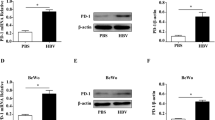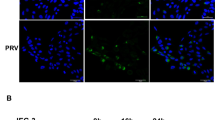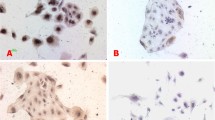Abstract
Objective
This study aims to understand the difference of HBxAg and PI3K signal transduction protein expressions in HBV-infected placenta and normal placenta, clarify the difference of the two in the degree of apoptosis and explore the potential role of inhibition of HBxAg/PI3 K/apoptosis in HBV intrauterine infection.
Methods
Placenta tissues of 24 pregnant women with confirmed intrauterine infection and positive HBsAg were selected as the infection group, and those of normal healthy pregnant women were taken as the control group. Immunohistochemical SP staining method was employed to detect the expressions of HBxAg and PI3K in the placenta of each group, and TUNEL was applied for the assay of apoptosis.
Results
HBxAg was detected in the placenta of HBV-infected group, and staining optical density value of high replication group (HBV DNA >1 × 103 copies/mL) was higher than that of low replication group (HBV DNA <1 × 103 copies/mL), and there was statistical significance (p < 0.05); PI3K expression levels in the placenta of HBV-infected groups were higher than that of the control group and there was statistical significance (p < 0.01), and staining optical density value of high replication group was higher than that of low replication group and it was statistically significant (p < 0.01); apoptosis index of HBV-infected high replication group was lower than that of low replication group and control group and there was statistical significance (p < 0.01).
Conclusion
HBV infected placenta tissues and then produced functional proteins HBxAg in trophoblast cells, and HBxAg/PI3 K/anti-apoptosis is the potential mechanism for pregnant women with HBV DNA high replication to have intrauterine infection while there exists different mechanism for pregnant women with negative HBV DNA.




Similar content being viewed by others
References
Yao JL (1996) Perinatal transmission of hepatitis B virus infection and vaccination in China. Gut 38(2):37–38
Yu MW, Chang HC, Liaw YF et al (2000) Familial risk of hepatocellular carcinoma among chronic hepatitis B carriers and their relatives. J Natl Cancer Inst 92(14):1159–1164
Gao Y, Zhao X, HX M (2008) The research on neonatal immune failure of hepatitis virus vertical transmission. Guide of China Medicine 6(2):159–161
Zhang SL, Yue YF, Bai GQ, Shi L, Jiang H (2004) Mechanism of intrauterine infection hepatitis B virus. World J Gastroenterol 10:437–438
Haun L, Kwan N, Hollier LM (2007) Viral infections in pregnancy. Minerva Ginecol 59:159–174
Wang XP, Li FJ, Xu DZ, Yan YP, Men K, Zhang JX (2001) Uptake of hepatitis B virus into choriocarcmoma cells in the presence of proinflammatory cytokine tumor necrosis factor—alpha. Am J Obstet Gynecol 185:981–987
Wang WH, Studach LL, Andrisani OM (2011) Proteins ZNF198 and SUZ12 are down-regulated in hepatitis B virus (HBV) X protein-mediated hepatocyte transformation and in HBV replication. Hepatology 53(4):1137–1147
Zheng Y, Chen WL, Louie SG et al (2007) Hepatitis B virus promotes hepatocarcinogenesis in transgenic mice. Hepatology 45(1):16
Shin D, Kim SI, Kim M et al (2006) Efficient inhibition of hepatitis B virus replication by small interfering RNAs targeted to the viral X gene in mice. Virus Res 119(2):146–153
Pang R, Tse E, Poon RT (2006) Molecular pathways in hepatocelhlar carcinoma. Cancer Lett 240(2):157–169
Hong L, Zhang J, Min J et al (2010) A role for MHBst167/HBx in hepatitis B virus-induced renal tubular cell apoptosis. Nephrol Dial Transplant 25(7):2125–2133
Benhenda S, Cougot D, Buendia MA et al (2009) Hepatitis B virus X protein molecular functions and its role in virus life cycle and pathogenesis. Adv Cancer Res 103:75–109
Lee C, Gong Y, Brok J et al (2006) Effect of hepatitis B immunization in newborn infants of mother positive for hepatitis B surface antigen: systematic review and metaanalysis. J BMJ 332:328–336
Xu DZ, Yan YP, Zou S et al (2001) Role of placental tissues in the in-trauterire transmission of hepatitisB virus. Am J Obstet Gynecol 185(4):981–987
Bai GQ, Yue YF, Zhang SL et al (2007) Screening of differentially expressed genes in placentas with hepatitis B virus infection by suppression subtractive hybridization technique. Chin J Gynecol Obstet 42(2):76–78
Waris G, Huh KW, Siddiqui A (2001) Mitochondrially associated hepatitis B virusX protein constitutively activates transcription fac-tors STAT- 3 and NF-κB via oxidative stress. J Mol Cell Biol 21(22):7721–7730
Xu ZM, Yen TSB, Wu LY et al (2002) Enhancement of hepatitis B virus replication by its X protein in transgenic mice. J Virol 76(5):2579–2584
Huang XL, Cui GH, Zhou KY (2008) Correlation of PI3K-Akt Signal Pathway to Apoptosis of Tumor Cells. Chin J Cancer 27(3):331–336
Zhu R, Li BZ, Li H et al (2007) Association of p16 (INK4A) hypermethylation with hepatitis B virus X protein expression in the early stage of HBV-associated hepatocarcinogenesis. Pathol Int 57(6):328–336
Conflict of interest
None.
Author information
Authors and Affiliations
Corresponding author
Rights and permissions
About this article
Cite this article
Bai, G., Wang, Y., Zhang, L. et al. The study on the role of Hepatitis B virus X protein and apoptosis in HBV intrauterine infection. Arch Gynecol Obstet 285, 943–949 (2012). https://doi.org/10.1007/s00404-011-2096-2
Received:
Accepted:
Published:
Issue Date:
DOI: https://doi.org/10.1007/s00404-011-2096-2




